2007 CHEVROLET SILVERADO charging
[x] Cancel search: chargingPage 206 of 684

Warning Lights, Gages, and Indicators..... 248
Instrument Panel Cluster........................... 249
Speedometer and Odometer...................... 250
Trip Odometer........................................... 250
Tachometer............................................... 250
Safety Belt Reminder Light........................ 251
Passenger Safety Belt Reminder Light
(1500 Series)......................................... 251
Airbag Readiness Light............................. 252
Airbag Off Light......................................... 252
Passenger Airbag Status Indicator............. 254
Charging System Light.............................. 256
Voltmeter Gage......................................... 257
Brake System Warning Light..................... 258
Anti-Lock Brake System Warning Light...... 259
StabiliTrak
®Indicator Light......................... 260
Engine Coolant Temperature Gage............ 260
Tire Pressure Light.................................... 261
Malfunction Indicator Lamp........................ 262Oil Pressure Gage..................................... 265
Oil Pressure Light..................................... 266
Security Light............................................ 266
Fog Lamp Light......................................... 267
Cruise Control Light.................................. 267
Highbeam On Light................................... 267
Four-Wheel-Drive Light.............................. 267
Tow/Haul Mode Light................................ 268
Fuel Gage................................................. 268
Low Fuel Warning Light............................ 269
Driver Information Center (DIC).................. 269
DIC Operation and Displays
(With DIC Buttons)................................. 270
DIC Operation and Displays
(Without DIC Buttons)............................ 277
DIC Warnings and Messages.................... 281
DIC Vehicle Customization
(With DIC Buttons)................................. 291
Section 3 Instrument Panel
206
Page 229 of 684
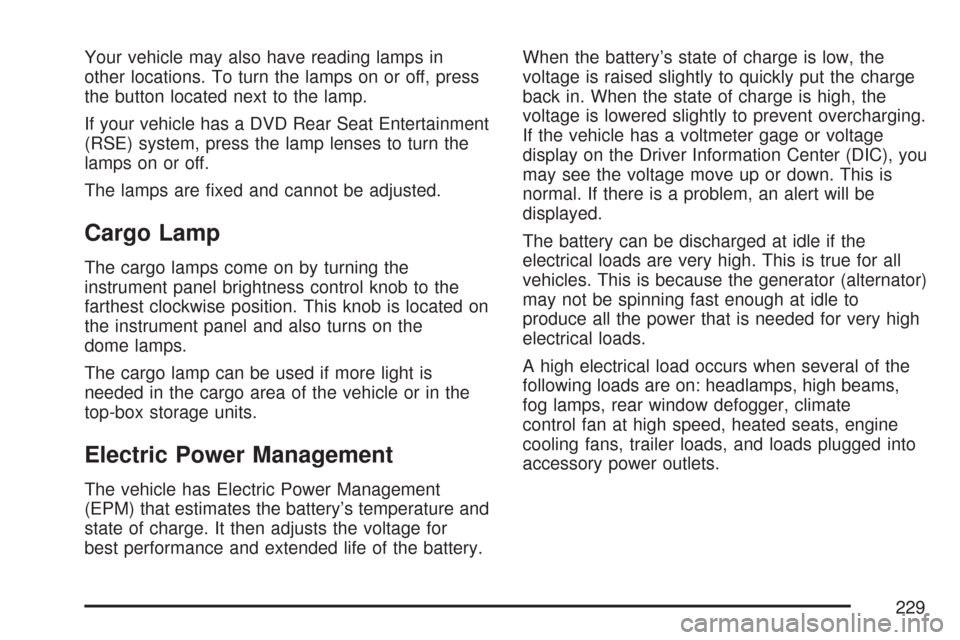
Your vehicle may also have reading lamps in
other locations. To turn the lamps on or off, press
the button located next to the lamp.
If your vehicle has a DVD Rear Seat Entertainment
(RSE) system, press the lamp lenses to turn the
lamps on or off.
The lamps are �xed and cannot be adjusted.
Cargo Lamp
The cargo lamps come on by turning the
instrument panel brightness control knob to the
farthest clockwise position. This knob is located on
the instrument panel and also turns on the
dome lamps.
The cargo lamp can be used if more light is
needed in the cargo area of the vehicle or in the
top-box storage units.
Electric Power Management
The vehicle has Electric Power Management
(EPM) that estimates the battery’s temperature and
state of charge. It then adjusts the voltage for
best performance and extended life of the battery.When the battery’s state of charge is low, the
voltage is raised slightly to quickly put the charge
back in. When the state of charge is high, the
voltage is lowered slightly to prevent overcharging.
If the vehicle has a voltmeter gage or voltage
display on the Driver Information Center (DIC), you
may see the voltage move up or down. This is
normal. If there is a problem, an alert will be
displayed.
The battery can be discharged at idle if the
electrical loads are very high. This is true for all
vehicles. This is because the generator (alternator)
may not be spinning fast enough at idle to
produce all the power that is needed for very high
electrical loads.
A high electrical load occurs when several of the
following loads are on: headlamps, high beams,
fog lamps, rear window defogger, climate
control fan at high speed, heated seats, engine
cooling fans, trailer loads, and loads plugged into
accessory power outlets.
229
Page 230 of 684

EPM works to prevent excessive discharge of the
battery. It does this by balancing the generator’s
output and the vehicle’s electrical needs. It
can increase engine idle speed to generate more
power, whenever needed. It can temporarily
reduce the power demands of some accessories.
Normally, these actions occur in steps or levels,
without being noticeable. In rare cases at the
highest levels of corrective action, this action may
be noticeable to the driver. If so, a Driver
Information Center (DIC) message might be
displayed, such as Battery Saver Active or Service
Battery Charging System. If this message is
displayed, it is recommended that the driver
reduce the electrical loads as much as possible.
SeeDIC Warnings and Messages on page 281.
Battery Run-Down Protection
This feature shuts off the dome and reading
lamps, if they are left on for more than 10 minutes
when the ignition is turned off. The cargo lamp
will shut off after 20 minutes. This will keep
the battery from running down.
Ultrasonic Rear Parking
Assist (URPA)
If your vehicle has the Ultrasonic Rear Parking
Assist (URPA) system it is designed to help you
park while in Reverse (R). It operates only at
speeds less than 5 mph (8 km/h). URPA helps
make parking easier and helps you avoid colliding
with objects such as parked vehicles. The URPA
system detects objects that are close to the rear of
the vehicle which are at least 10 inches (25.4 cm)
off the ground and below hood or trunk level. The
system detects objects up to 8 feet (2.5 m) behind
your vehicle. The URPA sensors determine how
close these objects are from your bumper within
this area.
230
Page 256 of 684

If, after several seconds, both status indicator
lights remain on, or if there are no lights at
all, there may be a problem with the lights or the
passenger sensing system. See your
dealer/retailer for service.
{CAUTION:
If the airbag readiness light in the
instrument panel cluster ever comes on
and stays on, it means that something may
be wrong with the airbag system. If this
ever happens, have the vehicle serviced
promptly, because an adult-size person
sitting in the right front passenger’s seat
may not have the protection of the
airbag(s). SeeAirbag Readiness Light on
page 252for more on this, including
important safety information.
Charging System Light
If this light comes on
when the engine is
running, there could be
a problem with the
charging system.
This light will also stay on while the key is in RUN
until the engine is started.
If the light stays on after starting the engine it
could indicate a problem with the generator drive
belt, or some other charging system problem.
Have it checked right away. Driving while this light
is on could drain the battery.
If you must drive a short distance with this light
on, it helps to turn off all of the electrical
accessories, such as the radio and the blower.
256
Page 257 of 684
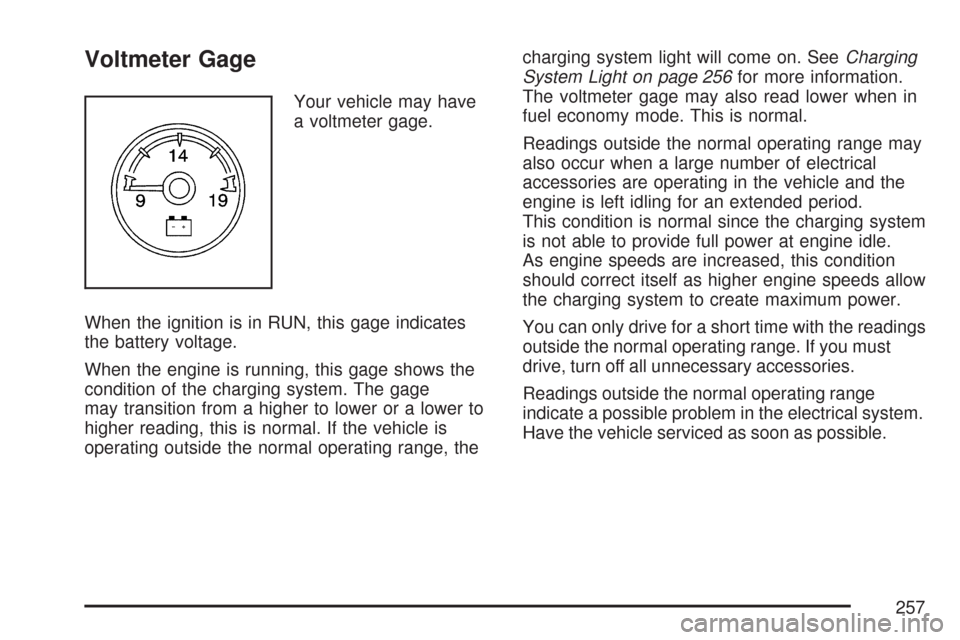
Voltmeter Gage
Your vehicle may have
a voltmeter gage.
When the ignition is in RUN, this gage indicates
the battery voltage.
When the engine is running, this gage shows the
condition of the charging system. The gage
may transition from a higher to lower or a lower to
higher reading, this is normal. If the vehicle is
operating outside the normal operating range, thecharging system light will come on. SeeCharging
System Light on page 256for more information.
The voltmeter gage may also read lower when in
fuel economy mode. This is normal.
Readings outside the normal operating range may
also occur when a large number of electrical
accessories are operating in the vehicle and the
engine is left idling for an extended period.
This condition is normal since the charging system
is not able to provide full power at engine idle.
As engine speeds are increased, this condition
should correct itself as higher engine speeds allow
the charging system to create maximum power.
You can only drive for a short time with the readings
outside the normal operating range. If you must
drive, turn off all unnecessary accessories.
Readings outside the normal operating range
indicate a possible problem in the electrical system.
Have the vehicle serviced as soon as possible.
257
Page 287 of 684
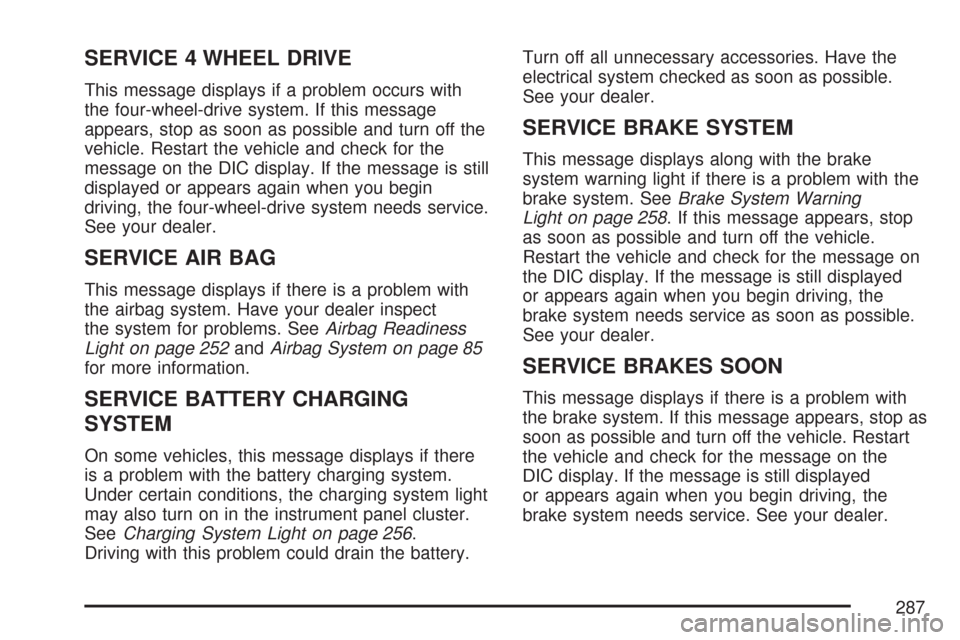
SERVICE 4 WHEEL DRIVE
This message displays if a problem occurs with
the four-wheel-drive system. If this message
appears, stop as soon as possible and turn off the
vehicle. Restart the vehicle and check for the
message on the DIC display. If the message is still
displayed or appears again when you begin
driving, the four-wheel-drive system needs service.
See your dealer.
SERVICE AIR BAG
This message displays if there is a problem with
the airbag system. Have your dealer inspect
the system for problems. SeeAirbag Readiness
Light on page 252andAirbag System on page 85
for more information.
SERVICE BATTERY CHARGING
SYSTEM
On some vehicles, this message displays if there
is a problem with the battery charging system.
Under certain conditions, the charging system light
may also turn on in the instrument panel cluster.
SeeCharging System Light on page 256.
Driving with this problem could drain the battery.Turn off all unnecessary accessories. Have the
electrical system checked as soon as possible.
See your dealer.
SERVICE BRAKE SYSTEM
This message displays along with the brake
system warning light if there is a problem with the
brake system. SeeBrake System Warning
Light on page 258. If this message appears, stop
as soon as possible and turn off the vehicle.
Restart the vehicle and check for the message on
the DIC display. If the message is still displayed
or appears again when you begin driving, the
brake system needs service as soon as possible.
See your dealer.
SERVICE BRAKES SOON
This message displays if there is a problem with
the brake system. If this message appears, stop as
soon as possible and turn off the vehicle. Restart
the vehicle and check for the message on the
DIC display. If the message is still displayed
or appears again when you begin driving, the
brake system needs service. See your dealer.
287
Page 481 of 684
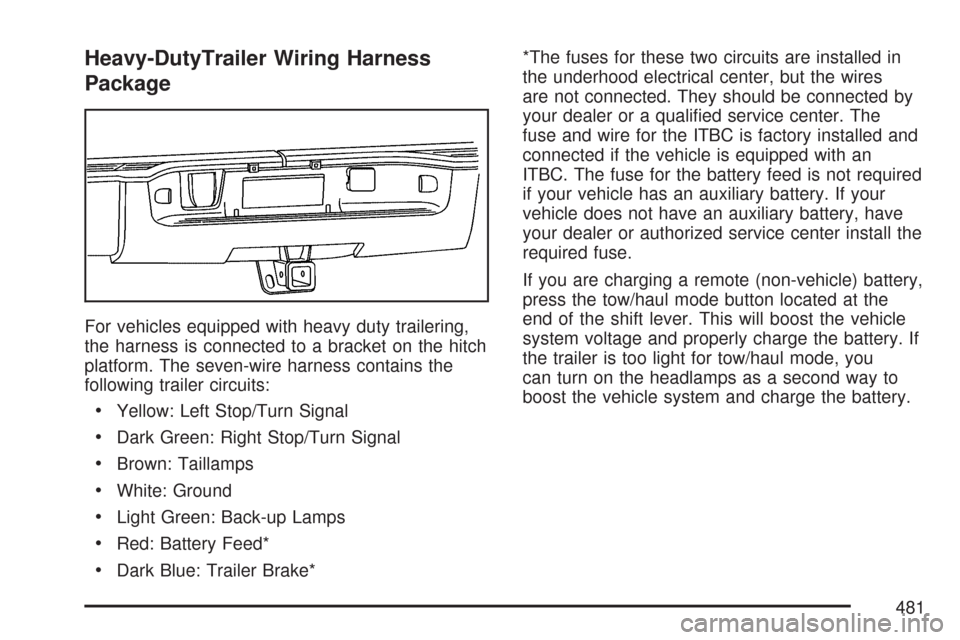
Heavy-DutyTrailer Wiring Harness
Package
For vehicles equipped with heavy duty trailering,
the harness is connected to a bracket on the hitch
platform. The seven-wire harness contains the
following trailer circuits:
Yellow: Left Stop/Turn Signal
Dark Green: Right Stop/Turn Signal
Brown: Taillamps
White: Ground
Light Green: Back-up Lamps
Red: Battery Feed*
Dark Blue: Trailer Brake**The fuses for these two circuits are installed in
the underhood electrical center, but the wires
are not connected. They should be connected by
your dealer or a quali�ed service center. The
fuse and wire for the ITBC is factory installed and
connected if the vehicle is equipped with an
ITBC. The fuse for the battery feed is not required
if your vehicle has an auxiliary battery. If your
vehicle does not have an auxiliary battery, have
your dealer or authorized service center install the
required fuse.
If you are charging a remote (non-vehicle) battery,
press the tow/haul mode button located at the
end of the shift lever. This will boost the vehicle
system voltage and properly charge the battery. If
the trailer is too light for tow/haul mode, you
can turn on the headlamps as a second way to
boost the vehicle system and charge the battery.
481
Page 671 of 684
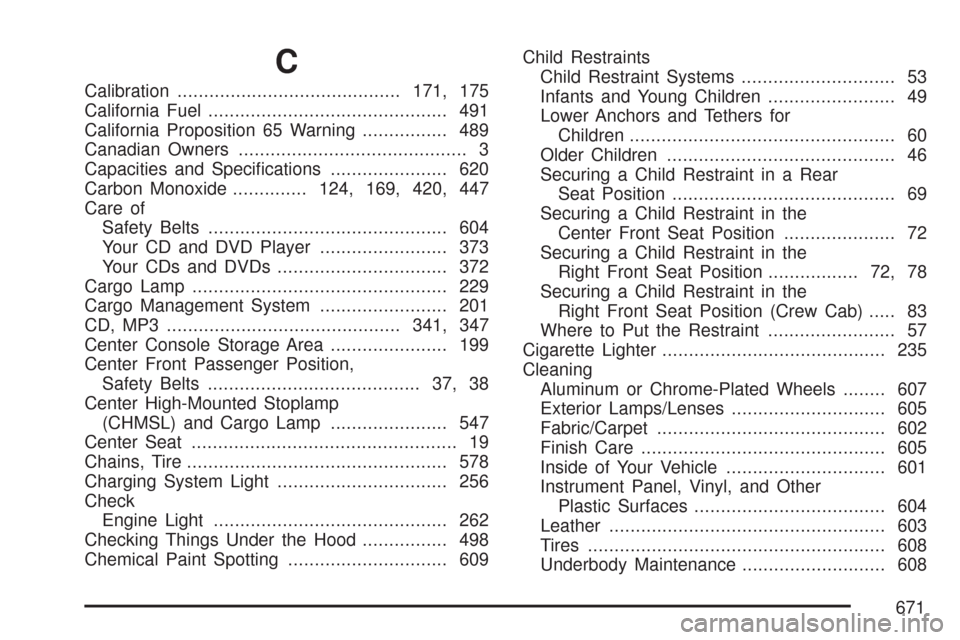
C
Calibration..........................................171, 175
California Fuel............................................. 491
California Proposition 65 Warning................ 489
Canadian Owners........................................... 3
Capacities and Speci�cations...................... 620
Carbon Monoxide..............124, 169, 420, 447
Care of
Safety Belts............................................. 604
Your CD and DVD Player........................ 373
Your CDs and DVDs................................ 372
Cargo Lamp................................................ 229
Cargo Management System........................ 201
CD, MP3 ............................................341, 347
Center Console Storage Area...................... 199
Center Front Passenger Position,
Safety Belts........................................ 37, 38
Center High-Mounted Stoplamp
(CHMSL) and Cargo Lamp...................... 547
Center Seat.................................................. 19
Chains, Tire................................................. 578
Charging System Light................................ 256
Check
Engine Light............................................ 262
Checking Things Under the Hood................ 498
Chemical Paint Spotting.............................. 609Child Restraints
Child Restraint Systems............................. 53
Infants and Young Children........................ 49
Lower Anchors and Tethers for
Children.................................................. 60
Older Children........................................... 46
Securing a Child Restraint in a Rear
Seat Position.......................................... 69
Securing a Child Restraint in the
Center Front Seat Position..................... 72
Securing a Child Restraint in the
Right Front Seat Position................. 72, 78
Securing a Child Restraint in the
Right Front Seat Position (Crew Cab)..... 83
Where to Put the Restraint........................ 57
Cigarette Lighter.......................................... 235
Cleaning
Aluminum or Chrome-Plated Wheels........ 607
Exterior Lamps/Lenses............................. 605
Fabric/Carpet........................................... 602
Finish Care.............................................. 605
Inside of Your Vehicle.............................. 601
Instrument Panel, Vinyl, and Other
Plastic Surfaces.................................... 604
Leather.................................................... 603
Tires........................................................ 608
Underbody Maintenance........................... 608
671